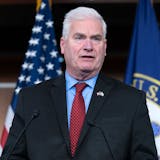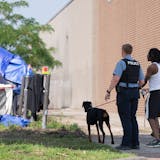Recent high-profile terror attacks pose a new challenge for police and intelligence services. All seem to be the work of lone-wolf actors. Yet police and intelligence services, by the nature of their work, target groups. It's possible to adjust that focus, but that would require Western societies to make an important trade-off.
On Monday, a 17-year-old Afghan asylum seeker gravely wounded four fellow passengers with an ax and a knife on a regional train near Wuerzburg in Germany before police shot him to death. The attack continues a series of terrorist acts by loners: the shooting in Orlando in June, the truck rampage in Nice last week, the cop shootings in Dallas and Baton Rouge. ISIL claimed responsibility for Orlando, Nice and Wuerzburg, but that's merely in keeping with its status as the umbrella brand for Islamist terror. The killers weren't members of any terror group, and they weren't acting on anyone's orders.
Yet the Orlando and Nice attacks had so many casualties — a combined 133 people dead and dozens more wounded — that an organized group could hardly have been more effective. The November attacks in Paris, which were actually planned by an ISIL affiliate, took 130 lives.
A full-scale military operation against ISIL or active intelligence work against it wouldn't have prevented the attacks by people who flew under the conventional radar, never traveling to the Syrian war zone or hanging out with known terror operatives. Besides, the lone-wolf phenomenon has little to do with any particular ideology, though the ISIL banner has seen some heavy use lately (sometimes even literally: The Wuerzburg assailant had a hand-painted ISIL flag with him). As Jerrold Post wrote in "The Mind of the Terrorist," "the cause is not the cause."
"Lone wolf" is a term popularized in the 1990s by white supremacists Tom Metzger and Alex Curtis, who called on like-minded people to commit uncoordinated acts of terror. Some of the deadliest of the predatory species have been white racists: Norway's deadliest killer Anders Breivik, Austrian letter bomber Franz Fuchs, "London Nail Bomber" David Copeland, Charleston church shooter Dylann Roof, Oklahoma City bomber Timothy McVeigh. It's likely, though, that their ideologies ran only skin deep, just as radical Islam does for the recent killers of Middle Eastern and North African extraction.
"The conscious belief system," psychiatrists J. Reid Meloy and Jessica Yakeley wrote in a 2014 psychological analysis of lone-wolf terrorists, "is upon closer examination often quite superficial: a cherry-picked cluster of prescriptive or proscriptive statements that provide a broad rationalization for the homicidal aggression."
It's enough for a system to be simple and binary, pitting good against evil, for it to serve as a justification for extreme violence. "Such defensive maneuvers are often part of a pathological narcissism in which the good object is within and the bad objects are all without," Meloy and Yakeley wrote.
The narcissism is an obstacle to affiliating with an actual terrorist group, the psychiatrists pointed out — but it tends to strengthen the lone terrorists' dependence on virtual communities, such as those formed on the internet. There, communication is free from the constant trauma of real-world interactions. That trauma is ever-present in lone-wolf terrorists' stories — rejection by a father, a nonexistent or troubled sex life, professional or academic underachievement. On the internet, none of this matters.



